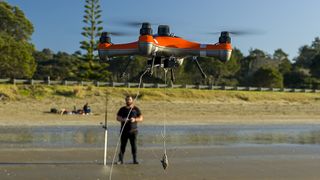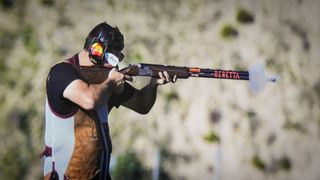The best drone for fishing is one that uses a polarizing lens to look directly into the water and help you pick the perfect spot. Some special features can assist in the process further, such as SwellPro’s bait release systems. These can be controlled remotely, or simply through tension you apply to the line with the drone. Also, if you like to fish in one particular spot, creating a detailed satellite-style map is easy with a drone, which why we’ve included a number with good cameras on this list.
When choosing the best drone for fishing, it’s a good idea to look at range – the maximum distance you can control the drone and still see a video signal back. Even if your national regulations don’t allow you to fly this far, it gives a good idea of the quality of the radio signal you can expect.
If you've never flown a drone before, you might be worried about crashing it. Well, don't stress. Every drone on this list features GPS hover in at least one of the flight modes. That means you’ll be able to take off, fly around, and let go of the controls, with no worries that the aircraft will plummet from the sky. Collision avoidance sensors can also be found on pricier drones.
- Also read: the best underwater drones.
The best drones for fishing in 2023
Why you can trust Digital Camera World Our expert reviewers spend hours testing and comparing products and services so you can choose the best for you. Find out how we test.

If you’re able to take off from dry ground, this is a near perfect choice in terms of visual quality, with a 1080p livestream. There are plenty who would be jealous of this drone in the photography or cinematography space. While, like many, it isn't waterproof, the gimbal-stabilized camera can be directed straight down and has an easy filter attachment system, so it's possible to add a polarizing lens and penetrate the surface of a lake.
The folding design makes it portable, and the propellors are relatively quiet. powerful motors mean it can make its way home in strong winds. DJI provides high quality charging tools and the control app is easy to use, even for beginners, while offering advanced features where required.
The Air 2S also features an array of collision avoidance sensors, meaning you can fly through trees and it’ll plot a route around them rather than plough into them. For more details, see our DJI Air 2S review.
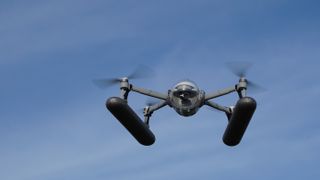
PowerVision is known for its underwater drones, as well as this uniquely adaptable aerial one. It requires a little on-site assembly – especially if you’re using the waterproof housing and floating landing skids – but in exchange you have a reasonably powerful drone with a competitive battery life which can land on the surface of the water, and lift itself off again.
PowerVision makes no specific claims for speed, but it’ll remain controllable in Beaufort Scale 5 winds, which isn’t to be sniffed at. The live view to a mobile phone (connected to the remote) gives a clear view of what the camera is seeing, and the app is reasonably intuitive. If you want to narrate your lake-mapping you can use your phone’s microphone to record your thoughts onto the video from the drone.
The three-axis gimbal provides stable video and while the camera sensor is a standard 1 / 2.8 inch CMOS (like a typical phone), the picture is plenty sharp for fish finding. Then, if you change activities, you can take the drone body out of its arms and just use the ‘egg’ as a stabilized action camera – adaptable! For more details, see our Powervision PowerEgg X drone review.
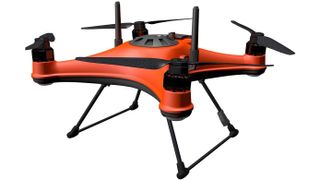
An IP67 waterproof drone built for the water? You bet. At over 2kg, with capacity for a load of about the same again (that’s around 25 pieces of bait on a line) the SplashDrone 4 is a powerful – if a little pricey – option. Especially when paired with the PL1-S bait release mechanism.
The orange shell of the drone can float and take off from water; if it finds itself the wrong way up, it can even flip itself upright, which is stunning to watch. You get all the usual drone treats that a high-end consumer pilot would expect, including high-res live view and intelligent follow, thanks to the NaviFly app (note: you'll need a phone clipped atop the remote control). Plus there are delightful extras, like the bait release, more traditional feeling buttons and switches on the IP66-waterproof remote.
SwellPro support their SplashDrone series of drones with a number of payload release mechanisms for “skytrolling,” so you can troll for fish up to 1.6km from the shore without a boat.

The DJI Mini SE was created as the entry-point to the leading drone manufacturer’s range. As such it might leave a few of the latest features out, and the camera’s 2.7K video recording irks some tech heads, but the 720P live video to the phone monitor is crisp and clean, especially now.
The new DJI Mini SE 2, first shipping in 2023, hasn’t made any significant changes to that success story except an improvement to the radio system which to DJI’s O2 standard, giving it a range of 6.2 miles in the US, or 6000m (3.7m) in UK/EU markets, and improving the bit rate of the live preview.
It also shares the same well maintained and easy-to-use software with other DJI drones, making it easy to learn. The camera gets a sharp image because it's on a gimbal, which also allows you to remotely tilt it to point down to the water.
Crucially… drum roll please… the Mini is also just under the weight limit which requires registration. This means that if you’re in the USA, you won’t need to do any paperwork with the FAA.
Check our DJI Mini SE vs Mini SE 2 comparison

This certainly looks like a piece of marine equipment, and for some the optional TrollSafe bait release tool this will be a must-have. It works when you fly your line out and it reaches a certain tension, releasing the bait and line.
It’s also a very exciting drone, built on powerful motors. Sometimes this can be a little bit of an issue: GPS return to home can be a touch enthusiastic. But SwellPRO have made refinements to the design and software since the first edition. That’s good, because underneath there is the heart of an FPV racing drone.
That means you get very low latency video feedback, and the option of goggles for FPV view, but on the downside the resolution you view on the monitor is not as high as the more photography-oriented drones like those from DJI. On the plus side, there's a color screen built into the remote control, which is waterproof.
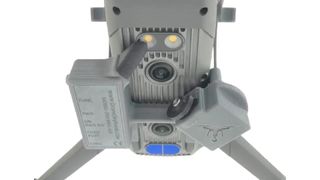
Want a drone that can drop bait for you? This is forbidden in some countries, including the UK, but otherwise here's our top recommendation.
Drone Sky Hook has made a number of variants of their Sky Hook to clip onto different DJI airframes, including the Mavic line all the way up to the 3, the Mavic Air series, and Phantom 4. The device is a rounded latch which, when activated, makes a turn, enough for anything dangling from it to be released.
The trigger to activate the latch is a light sensor. This is positioned at the drone’s built in landing lights and the instructions tell you to assign one of your remote control keys to the lights. Failing that, two full anti-clockwise rotations can also trigger the release.
The mechanism does slightly obscure the lower sensors on the Mavic 3, and undoubtedly would rule out a DJI Care Refresh claim, but the drone can still fly. The reduction on your overall flight time will depend on the weight, and the motors will be subject to some stress, but DJI also sell some accessories (like lights) so they are built to cope.
Is drone fishing legal?
The legality of drone fishing varies depending on where you are. It is important to check with your local authorities to find out the specific rules that apply in your area. For example, in the UK you're forbidden from dropping anything from drones, which effectively rules out any drone with a dropping mechanism, or an accessory like the Sky Hook. Assuming you’re not taking off in international waters, you’ll be bound by the rules of your local aviation authority. In the USA, that's the Federal Aviation Administration (FAA). In the UK, it's the Civil Aviation Authority (CAA).
What are the benefits of using a drone for fishing?
Drones can be used to scout for fish from the air, allowing you to target specific fish species or schools of fish. This also helps you fish more efficiently by reducing the time spent casting and retrieving lines. Drones can be used to cast bait and hooks into areas that are difficult or impossible to reach by traditional methods, such as deep water, reefs, or areas with overhanging vegetation (however, this may not be legal in specific areas, so always check the regulations).
How do I choose a drone for fishing
There are a number of different drones that can be used for fishing, so choosing between them will depend largely on your specific needs. First, consider payload capacity: the drone should be able to carry the weight of your bait, hook, and line. Also think about how long you're likely to be out fishing on a given day, and how much battery life you'll need in a drone should have enough battery life to last for several hours of fishing. The drone will also have enough range to reach the areas you want to fish in.
Read more
• Best indoor drones
• Best camera drones
• Best drones for kids
• Best travel drones
• The best drone accessories
• Drone rules and regulations
• Best waterproof camera
• Best handheld GPS
• Best head torch
